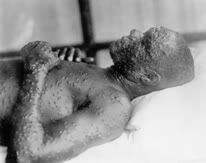Viral eradication and the evolution of smallpox
 The control and eventual eradication of the smallpox virus from the wild is one of the most heralded success stories in all of public health. Indeed, smallpox has played a central role in the history of vaccination. Even prior to Edward Jenner’s use of the related cowpox virus to protect against smallpox disease, it was known that inoculation with materials from an infectious smallpox pustule or scab (dubbed “variolation”) could protect an individual from death due to smallpox, generally resulting instead in a mild form of the illness. Jenner’s observation that milkmaids seemed to be protected from the disease–and his use of material from cowpox pustules instead of smallpox–resulted in the development of the science of vaccination. World-wide use of the smallpox vaccine, along with a mass vaccination campaign led by the World Health Orgainzation, resulted in the end of naturally-occurring smallpox on the planet, with the exception of stores of the virus held in the United States and Russia.
The control and eventual eradication of the smallpox virus from the wild is one of the most heralded success stories in all of public health. Indeed, smallpox has played a central role in the history of vaccination. Even prior to Edward Jenner’s use of the related cowpox virus to protect against smallpox disease, it was known that inoculation with materials from an infectious smallpox pustule or scab (dubbed “variolation”) could protect an individual from death due to smallpox, generally resulting instead in a mild form of the illness. Jenner’s observation that milkmaids seemed to be protected from the disease–and his use of material from cowpox pustules instead of smallpox–resulted in the development of the science of vaccination. World-wide use of the smallpox vaccine, along with a mass vaccination campaign led by the World Health Orgainzation, resulted in the end of naturally-occurring smallpox on the planet, with the exception of stores of the virus held in the United States and Russia.
This feat is being attempted currently with measles and polio viruses, but it’s been much more difficult, and eradication of these viruses may never be attainable. Below, I discuss some aspects that are critical to a campaign that seeks to eradicate a disease, and a new paper on the evolution of smallpox viruses.
(Continued at Aetiology)
